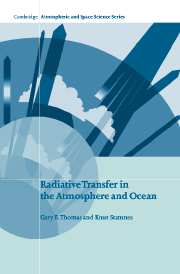Book contents
- Frontmatter
- Contents
- List of Illustrations
- Preface
- Acknowledgments
- Chapter 1 Basic Properties of Radiation, Atmospheres, and Oceans
- Chapter 2 Basic State Variables and the Radiative Transfer Equation
- Chapter 3 Basic Scattering Processes
- Chapter 4 Absorption by Solid, Aqueous, and Gaseous Media
- Chapter 5 Principles of Radiative Transfer
- Chapter 6 Formulation of Radiative Transfer Problems
- Chapter 7 Approximate Solutions of Prototype Problems
- Chapter 8 Accurate Numerical Solutions of Prototype Problems
- Chapter 9 Shortwave Radiative Transfer
- Chapter 10 Transmission in Spectrally Complex Media
- Chapter 11 Radiative Transfer in Nongray Media
- Chapter 12 The Role of Radiation in Climate
- Appendices
- A Nomenclature: Glossary of Symbols
- B Physical Constants
- C Model Atmospheres
- D Ocean Optics Nomenclature
- E Reflectance and Transmittance at an Interface
- Index
A - Nomenclature: Glossary of Symbols
Published online by Cambridge University Press: 18 December 2009
- Frontmatter
- Contents
- List of Illustrations
- Preface
- Acknowledgments
- Chapter 1 Basic Properties of Radiation, Atmospheres, and Oceans
- Chapter 2 Basic State Variables and the Radiative Transfer Equation
- Chapter 3 Basic Scattering Processes
- Chapter 4 Absorption by Solid, Aqueous, and Gaseous Media
- Chapter 5 Principles of Radiative Transfer
- Chapter 6 Formulation of Radiative Transfer Problems
- Chapter 7 Approximate Solutions of Prototype Problems
- Chapter 8 Accurate Numerical Solutions of Prototype Problems
- Chapter 9 Shortwave Radiative Transfer
- Chapter 10 Transmission in Spectrally Complex Media
- Chapter 11 Radiative Transfer in Nongray Media
- Chapter 12 The Role of Radiation in Climate
- Appendices
- A Nomenclature: Glossary of Symbols
- B Physical Constants
- C Model Atmospheres
- D Ocean Optics Nomenclature
- E Reflectance and Transmittance at an Interface
- Index
Summary
So diverse are the number of applications of radiative transfer techniques that over the years a large variety of terms, symbols, and units have been used for the same set of quantities. This has caused much confusion and wasted effort. To rectify this situation many fields of physical science have established standards, sometimes by design and sometimes by de facto recognition of the usage of a single author. Although the issue of a standard set of units is by now settled, at least in the geophysical sciences, it is another matter when it comes to nomenclature and symbols.
An attempt to set forth a uniform set of nomenclature and symbols was made in 1978 by the Radiation Commission of the International Association of Meteorology and Atmospheric Physics. Although the SI system recommended by them has been adopted by most atmospheric and oceanic journals, there is not yet any degree of acceptance of nomenclature. For example, even in texts published in the 1990s, the basic quantity of radiation, the radiance L, is still referred to by its traditional name (intensity) and symbol I. Also, the irradiance E is frequently referred to by its familiar name flux and symbol F. Some of the factors explaining this lack of compliance are: (1) traditional inertia of workers trained in an earlier era; (2) the strong influence of a few classic references, such as that of S. Chandrasekhar; and (3) the uneven acceptance, or lack thereof, of the agreements adopted by the international scientific bodies, such as the International Commission on Illumination, the Commission for Symbols, Units and Nomenclature of the International Union of Pure and Applied Physics.
- Type
- Chapter
- Information
- Radiative Transfer in the Atmosphere and Ocean , pp. 481 - 488Publisher: Cambridge University PressPrint publication year: 1999



